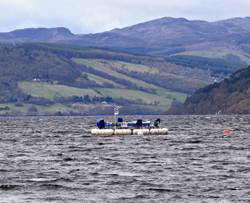Loch Ness Monster? No, Prototype Wave Energy Device
Scottish marine energy technology developer, AWS Ocean Energy, has started testing its new wave energy device in Loch Ness in the Scottish Highlands. The Inverness based company has deployed a 1/9th scale of its AWS-III device, a ring-shaped multi-cell surface-floating wave power system, the result of almost two years of intensive research and development work. AWS Ocean Energy is aiming to deploy a full-system prototype AWS-III during 2012 and a pre-commercial demonstrator plant during 2013.
Simon Grey, Chief Executive of AWS Ocean Energy said: “In developing the design of the AWS-III, we believe we have addressed the fundamental barriers to delivering practical wave energy. We have eliminated moving mechanical parts in contact with sea-water by using a novel system of flexible diaphragms arranged around a steel hull and incorporating air turbines.”
A single utility-scale AWS-III, measuring around 60 metres in diameter, will be capable of generating up to 2.5 Megawatts (MW) of continuous power, providing customers with an affordable solution to generating bulk power from the ocean waves.
To support the development of the AWS-III, the company earlier this year secured a £2.3 million investment from Scottish Enterprise’s Scottish Co-investment Fund and the Shell Technology Ventures Fund 1 B.V and the company has since applied for and is hopeful of securing further financial support for the development of the AWS-III device from the Scottish Government’s WATERS programme that will support marine energy R&D in Scotland.
A key stage now for AWS Ocean is its testing of the AWS-III device on Loch Ness over the next four months. No electricity will be generated by the 1/9th scale device but it will provide valuable design data and confirm the AWS-III’s revenue generation potential. The company will then build and deploy a full-scale single cell in order to prove the durability of the diaphragms prior to launching a 12-cell, 2.5MW pre-commercial demonstrator in 2012. Subject to financing and planning consents, the company plans to have a 10MW pre-commercial demonstration farm operating in 2014.
The design and deployment of the AWS-III is the culmination of eight years research and development by the company’s engineering team. AWS Ocean Energy deployed its first Archimedes Waveswing test device in 2004 (off Portugal) and designed a second generation device in 2008. Whilst the Waveswing concept was regarded as highly efficient, and competitive with other leading wave energy technologies, the company decided that further work was required to develop a third-generation system which could provide utility-scale levels of power and be competitive with other forms of renewables, in particular offshore wind generation.
During the development of the AWS-III, the in-house engineering team identified similarities to another wave device, the “Coventry Clam”, developed by Coventry University’s engineering department in the 1970s.
Simon Grey, Chief Executive of AWS Ocean Energy said: “We started with the highly efficient Waveswing concept and looked at different ways to achieve the change in sub-sea volume essential to efficient wave energy conversion. This led us to looking at flexible materials and in turn to the Coventry Clam, a device which had shown significant promise. The AWS-III however has important differences which solve some problems inherent in the clam design and improve power conversion.
“It is reassuring that two teams working some 30 years apart have come up with such similar concepts. The development routes were remarkably similar – the Coventry team started with the Salter Duck, a leading concept of its time whilst we started with Waveswing. Both concepts were highly efficient but too expensive and a natural evolution process led us both to the same point. The experience in Coventry, combined with our own has produced a cracking team and we believe a winning technology.”
In parallel with the development of the AWS-III, the company is developing associated, patented technologies such as remote mooring systems and believes there is significant potential for manufacturing key components in Scotland.







